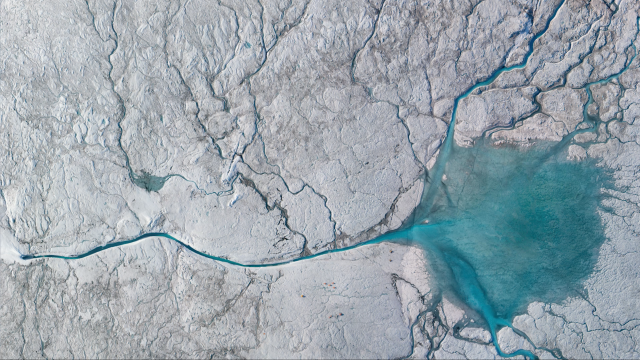We use the cliched term “glacial pace” to describe something that moves really slowly. But new research shows that Greenland’s glaciers may actually be moving more rapidly than we thought thanks to rushing rivers on their surface.
In 2015, a group of scientists took a NASA-funded expedition to the Russell Glacier in western Greenland to camp out on the melting ice. There, they observed the surface of the ice as well the complicated processes taking place under the Greenland ice sheet, which dictate how quickly glaciers slip into the ocean. Getting handle on what’s happening is vital because more ice falling into the ocean raises sea levels, threatening coasts everywhere. In a study published in Geophysical Research Letters on Monday, two of the expedition’s researchers explain their findings.
In Greenland, the team examined how water flows through cracks in the ice that form rivers. From looking at satellite images of the ice sheet, they could tell that massive amounts of water flow through these gaps. But they were still surprised to find that the volume of water that passes through them far surpasses the volume of water in glacial lakes.
“Much like the terrestrial surface, lakes catch your eye because they’re so big, but the real action, the real flux, is through these rivers,” Laurence Smith, a professor of environmental studies at Brown University who was on the research trip and co-authored the new study, explained in a video about the expedition.
The authors paid close attention to how these meltwater rivers that run through the ice form caverns, called moulins, when they meet crevasses or other weak parts of the glacier and pour down through the ice, creating sinkholes. The authors mapped out 539 of these large meltwater streams and found that 100% of them terminate in one of these cavities.
“At that point, the river is captured and it ceases to flow over the surface of the ice sheet and instead plummets down into the interior,” Smith said in the video.
To measure how quickly these rivers move, they sent autonomous drifters down three rivers that took GPS measurements to reveal how fast the water was flowing. They also worked in shifts to constantly measure streamflow for 72 hours straight. To do so, they used sonic beams to measure the depth of the water and speed of the current. The instrument was attached to a boogie board (seriously).
It was dangerous work. Since these rivers move quickly, the researchers had to be careful not to fall in and get swept into a cavern themselves. With these measurements, the team measured how increasing volumes of water in these caverns upped their water pressure, which drove higher velocities of streamflow into them.
This combination of water pressure and quick meltwater flow, the authors found, is making the ice more fragile and causing parts of the sheet to detach more quickly. This was true for caverns of all sizes, from 60 square kilometres to 2,800 square kilometres. The study marks the first time that field observations demonstrate this phenomenon. The findings also show that when water surged under the glacier, more ice slid into the ocean just a few hours later.
That wasn’t the only weird relationship they discovered. A repeat trip to Greenland in 2016 revealed that some meltwater was accumulating just beneath the surface of the ice, forming a sort of half-frozen slush. Until now, scientists have assumed that they could measure how quickly ice is melting by examining how much meltwater is on top of glaciers and how much water is accumulating in moulins. But the new findings indicate that that method might not work.
The study has major implications for scientists’ understanding of the Greenland ice sheet, and how quickly parts of it are breaking off. It adds a new component to improve projects about what could happen to the ice sheet that holds enough water to push sea levels up by 6.1 metres if it melted.
“These findings will help to refine ice sliding models, which are critically important for predicting future ice sheet contributions to global sea level rise,” Smith said in an email.
The new findings spell trouble for a region that’s already in peril. Just last week, another study found that winter cold isn’t enough to stop at least some of Greenland’s lakes from leaking into the ice sheet. And in recent years, the island has also seen an uptick in wildfires, higher summer temperatures, and lots more sun. Each of these products of the climate crisis are speeding up ice melt.
This is also horrifying news for the 56,000 people who live on the isle of Greenland, most of whom are Indigenous. Local communities rely on the ice for travel and hunting. Of course, ice melt in Greenland is also bad for the rest of us, because it contributes to sea level rise which can overwhelm coastal communities around the world. To slow this process as much as possible, our only option is to get a handle on our planet-warming greenhouse gas emissions.
